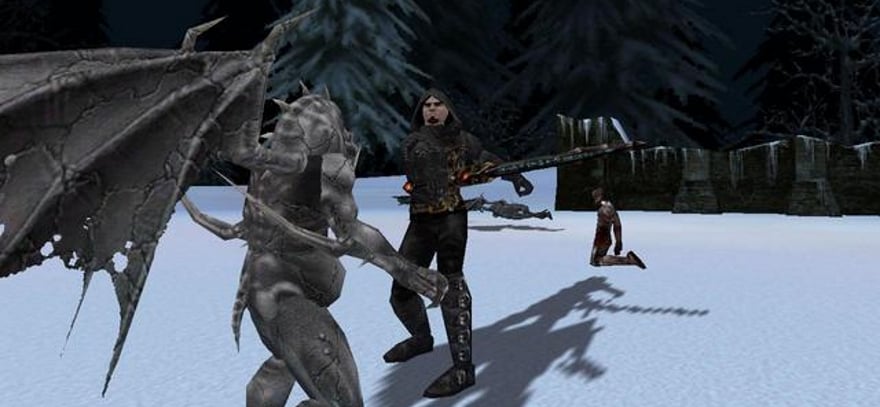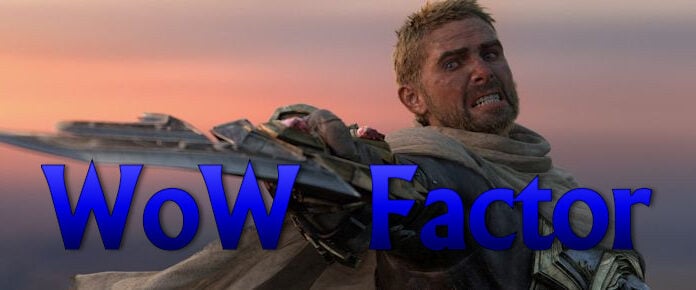
Way back when I used to haunt the corridors of Gamestop and had yet to shun the place due to its stinky evil, I remember being enticed with these fancy-pantsy “MMORPG” boxes when I’d see them on the shelf. I must have picked up Shadowbane a dozen or so times to check out the blurbs on the back, mentally weighing whether or not this would be the one to introduce me to online gaming, but ultimately it was not to be.
It’s probably for the best, considering that Shadowbane was primarily PvP and I’m a PvE guy at heart. Plus, the title never really took off the way that publisher Ubisoft had hoped, spending most of its six years of operation lurking in the background of the MMO industry instead of sharing the spotlight.
But still, six years! That’s not the worst run we’ve ever seen from an MMO. Considering that its creator has gone on to make Crowfall with some of the same ideas, it’s as timely as ever to take a look back at Shadowbane and what it brought to the table.
A lawless land
Created by former MUD developers, J. Todd Coleman and Joseph Hall, Shadowbane wasn’t bound by the constrictions of the current market. The two looked at the fallout from Ultima Online’s crackdown on PKers and the subsequent exodus of that community, figuring that there was a market for a PvP-focused title.
“It was a really, really cool idea… still is, actually: a real-time feudal war simulator,” Coleman later said. “But remember, we had no professional game development experience and no idea of what the cost (not just in terms of money) would be. And the MMO industry was still in its infancy, so there was no real standard for predicting a game like this. But we were young and stupid, so we just jumped in with both feet.”
Jump in they did, whipping up Shadowbane in a few short years before it launched in March 2003. Instead of having a strict structured PvE (EverQuest) or PvP (Dark Age of Camelot) focus, the dev team opted to put more tools and controls in the hands of players to make their own mayhem. Shadowbane eschewed most PvE content in favor of building a dynamic world where guilds and empires would struggle for supremacy.
The thought here was to make an ever-changing game where the players created a vast majority of the content (i.e., a sandbox). Actions made by players and guilds could and often did have a lasting impact on the game world itself, including modifying terrain and ordering guards to patrol certain paths.
Once players chose one of the game’s 12 races and four initial starting professions, they were set loose to level as fast as they could in order to join in on the PvP content. After a certain level, players could no longer retreat to the safety of the default cities, but were encouraged to find a guild to join. If the player was lucky, the guild would already have a headquarters to retreat to after a long day of adventuring.
“As far as the game, I really loved the depth and challenge,” Hall said. “There were literally millions of class combinations (with the various discipline runes). With so many interesting races, classes, and specializations, figuring out the best combinations was a game in and of itself.”
The developers likened Shadowbane to an MMO with real-time strategy elements, most notably in the creation and maintenance of guild cities. Villages were built from scratch and players could fill them with defenses, merchants and structures. No city was safe for too long, as the game’s unrestricted PvP system allowed for sieges to occur just about anywhere.
The politics of war
Because the game revolved around player-made cities, it stood to reason that they should be player-run as well. Ergo, Shadowbane included a political system that allowed gamers to be elected to office.
Associate Producer Louis Lamarche hoped that these political struggles would be as or more compelling than anything gamers had seen in MMOs to date, as he told GameZone: “The game system not only promotes conflict, but for the first time will foster true political maneuvering between player communities.”
The ambitious vision came with a price: the focus on a persistent world meant that the equilibrium of PvP struggles, as Hall put it, could and indeed were thrown off. The problem was the lack of a reset button to put the battle back at a status quo and keep the struggle fresh.
 Expanding
Expanding
Two expansions, Rise of Chaos and Throne of Oblivion, were released in 2003 and 2004 respectively. Rise of Chaos introduced a new character race, a pair of new classes, and additional areas, but took a drubbing by reviewers. Likewise, Throne of Oblivion was seen by some as adding more of the same and not worth the additional cost that the studio demanded. In other MMOs, these would have probably been free content updates, and by 2006 the expansions were included in the default client.
While we often point to Dungeons and Dragons Online as the prime example of a subscription-based MMO adopting a free-to-play (or hybrid) model, the truth is that titles like Anarchy Online and Shadowbane were experimenting with such models before 2009.
So how did this business model shift come about? Despite scoring generally favorable reviews, it was obvious that Shadowbane wasn’t going to tear up the charts following its 2003 release. At the time of launch, critics cited issues with the interface, lag, poor tutorial and lackluster graphics, although they did praise the game’s fun factor, fast pace, and innovative systems. The overall package wasn’t enough to draw in hundreds of thousands of players — never mind millions — and the title quickly sank into obscurity.
The population problem was partially solved when the game went free-to-play in March of 2006. The game was then financed by in-game ads that played at the beginning and end of every game session, as well as on certain character deaths.
And while it’s not a major thing, it’s important to note that Shadowbane shipped with both Mac and PC versions. That wasn’t very common at all back in the early 2000s, and even today not every major MMO is compatable with OSX.
The big reset
Shadowbane is notable for doing something that few MMOs have ever dared to do after a game’s gone live: It hit the reset button to start everything all over. This happened in early 2008 with Patch 22, as the devs declared that the game needed a fresh start to wipe out unbalanced items and bring all of the players onto the same world map. Prior to that patch, there were a few different versions of the game world in existence.
“It would be best for the longevity of the game to reset all server and character data and start from scratch,” the dev team wrote, and that was that.
Ultimately, a poor population and dwindling revenue meant that Shadowbane had to shut its doors. “We come to you now with regret and sadness, but also happiness and pride,” the team posted. “Regret and sadness that it has finally come to this and as of May 1st, 2009 the Shadowbane servers will be powered down once and for all. Yet happiness that it lasted so very long, and pride to be able to stand before such a passionate community to thank you for your undying support and unwavering loyalty to Shadowbane.”
After the playerbase rose up and sent in a mighty petition, Ubisoft changed its mind — sort of. Instead of closing up shop in May, the company decided to give players a two-month reprieve, moving Shadowbane’s final day to July 1st.
In an interesting postscript, Shadowbane was treated to a revival after its cancelation — in China. Changyou bought the rights and relaunched the game in the region as World of Shadowbane.
While most people can agree that Shadowbane was ultimately the case of good intentions coupled with poor execution, it can certainly be seen as a champion of open-world, sandbox PvP for its time. Will Crowfall pick up the spiritual baton and fly with the concept? One hopes so.
 Believe it or not, MMOs did exist prior to World of Warcraft! Every two weeks, The Game Archaeologist looks back at classic online games and their history to learn a thing or two about where the industry came from… and where it might be heading.
Believe it or not, MMOs did exist prior to World of Warcraft! Every two weeks, The Game Archaeologist looks back at classic online games and their history to learn a thing or two about where the industry came from… and where it might be heading.














